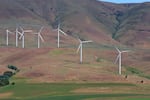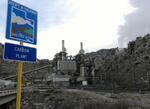
A view of Portland at dusk. Buildings, industry and especially transportation generate over two-thirds of emissions in Cascadia.
Curtis Gregory Perry / Flickr
To the rest of the world, the United States’ Pacific Northwest and Canada’s British Columbia represent one of the supposedly most eco-friendly regions in North America, if not the globe.
And yet on climate change, the biggest environmental challenge of this generation, the governments of Washington, Oregon and British Columbia not only over-promised what they would do to stem the tide, they actually underperformed compared to all the other states and provinces in the two countries, according to a new analysis by InvestigateWest.
More than a decade ago, the three governments set some of North America's first mandates to reduce greenhouse gas emissions. And if any place on earth can show the world how to confront the climate crisis, it should be this region, also known as "Cascadia" after the mountain chain shared by the two countries. Cascadia's abundant hydropower provides a head start toward living without fossil fuels, and the majority of voters in British Columbia, Washington and Oregon say they want to make that transition.
Yet Washington, British Columbia and Oregon were not on track to meet their 2020 targets. In fact, until COVID-19 hit last year, emissions were rising. Between 2013 and 2018, the most recent five-year period for which Cascadia’s governments have completed counts, emissions rose by about 5, 6 and 7% in Washington, Oregon and British Columbia, respectively, according to InvestigateWest’s analysis, which enabled apples-to-apples comparisons primarily by counting emissions associated with power imports in British Columbia.
“Emissions don’t lie and the emissions keep rising,” said Andrea Rodgers, an environmental attorney involved in litigation brought by youths in the states and British Columbia charging Oregon, Washington, and Canada with dereliction of duty in failing to live up to their promises to reduce climate-warming emissions.
Cascadia’s broken promise
Technologically speaking, climate change is neither insurmountable nor unaffordable. It’s the politics that have fallen short, according to experts and activists interviewed by InvestigateWest.
“I wouldn’t say we’ve done nothing. But there’s been an awful lot of dithering. We were supposed to do a whole hell of a lot better,” says KC Golden, who spent over a decade at Seattle-based think tank Climate Solutions and now serves on the board of international activist group 350.org.
The region’s fight to head off climate change has been beset by partisan wrangling, fear of job losses, disagreements over how to ensure equity for already polluted and marginalized communities, and misinformation obscuring the full potential of well-documented solutions.
“The constraining factor has always been political feasibility, not economic feasibility,” says political economist and energy modeling expert Mark Jaccard, a professor at Simon Fraser University in Burnaby, British Columbia, and a former chair of the British Columbia Utilities Commission.
The story of Cascadia’s decade of policy delay and emissions backsliding is a story of ambitious goals eroded by inertia. It’s a story of overestimating faith in economic logic and underestimating the enduring allure of economic growth. And, south of the 49th Parallel, it’s a tale of a bipartisan consensus split asunder, such that fighting for a cleaner future is seen, in some quarters, as an attack on freedom. Or worse.
Powering down coal
After 2005’s Hurricane Katrina and 2007’s record-breaking loss of Arctic sea ice, Cascadia lawmakers acted, mandating emissions reductions by 2020 and steeper cuts by 2050. As of 2008, Washington, British Columbia and Oregon were among only four provinces and eight states to legally commit to decarbonization.
Oregon and British Columbia set ambitious long-term goals of 75-77% reductions from their 1990 emissions, reflecting the global carbon cuts scientists believed were needed by mid-century to avert the worst of the impending climate disaster. Washington state came in with a relatively modest 50%-by-2050 goal.
All three governments chalked up quick wins in their power sectors.
British Columbia immediately scrapped plans for a new gas-fired power plant and two coal generators. Washington voters and Oregon’s Legislature passed some of North America’s first requirements mandating privately-owned utilities

Washington voters and Oregon’s Legislature passed some of North America’s first requirements mandating privately-owned utilities to add a rising share of wind, solar and other types of renewable power to their hydropower-rich energy portfolios.
Amelia Templeton / OPB
to add a rising share of wind, solar and other types of renewable power to their hydropower-rich energy portfolios.
This quick action unleashed a boom in wind power development, especially along the Columbia River Gorge, the natural wind tunnel that separates Oregon and Washington.
And guess what? It actually saved consumers money. Falling prices for wind and solar, driven by innovation and scale made the mandates more economical.
Cascadia’s problem was the rest of its economy. Buildings, industry and especially transportation generate over two-thirds of Cascadia’s emissions. Carbon-cutting options for those — such as electric heat pumps to replace gas furnaces and urban redesigns to reduce vehicle travel — were more complex and costly than swapping out coal smokestacks for wind turbines. And none of Cascadia’s governments had policies strong enough to forcefully drive those options into use.

The coal-fired Carbon Plant was closed by Portland-based PacifiCorp in 2015. It was part of the Rocky Mountain region Portland-based PacifiCorp and used to generate electricity for customers in six western states, including Oregon and Washington.
Cassandra Profita
Greenhouse gas emissions fell for several years thanks to cleaner electricity, as well as the global financial crisis of 2008. People traveled less, consumed less and produced less. Fossil fuel use dropped. Cascadia’s emissions fell by 8%. Then the economy rebounded. People moved more. Production and consumption rose. And climate-warming emissions came roaring back.
By 2018 robust economic growth across Cascadia had restored over four-fifths of the 19.5-megatons of annual emissions that the region shed during the downturn.
Surging emissions from cars, trucks, trains and planes led the way. Transportation accounted for nearly two-fifths of Cascadia’s emissions by the time its economies rebounded from the global economic meltdown in 2012. Six years later vehicle emissions had ballooned by over 10% in Washington and Oregon and 29% in British Columbia.
While some say increasing emissions are a price of economic growth, InvestigateWest’s analysis puts the blame squarely on Cascadia’s weak decarbonization policies. Political backlash and game-playing blocked measures to guide economic growth toward green technologies and strategies, and Cascadia’s economies kept growing along the path of least resistance. In a world awash in cheap fossil fuels, that meant more carbon emissions.
Not so in California, where climate policy moved forward, and emissions from transportation grew at less than half the rate in Cascadia.
Between full economic recovery in 2012 and 2018, the most recent reporting year, California and Cascadia both booked a robust 26% increase in GDP. Over that period California drove its annual emissions down by more than 5%. Washington’s emissions —and Cascadia’s as a whole — ballooned by over 7%.
Tracking Arnold
California “decoupled” economic growth from rising carbon via a raft of laws and policies that encouraged or mandated the use of efficient products and cleaner energy. Many were legislated in 2006 under then-Gov. Arnold Schwarzenegger, including the centerpiece: a system known as cap and trade. It set a cap on carbon emissions that declined annually and enforced that cap by requiring polluters to buy credits — sold at auction — for every ton of carbon they released. By putting a price on carbon, cap and trade created a financial incentive to reduce pollution.
Cascadia’s governments all sought to match the breadth of California’s carbon-cutting policies. They failed.
Early efforts in Washington and Oregon to enact cap-and-trade schemes fizzled. Washington approved a bill in 2008 that was later deemed unenforceable. Oregon ran out of time when the global economic meltdown struck that year.
British Columbia, in contrast, raced ahead. Like Schwarzenegger, then-Premier Gordon Campbell was a center-right politician who embraced climate action. British Columbia’s parliamentary government, with its fewer checks on power than the U.S. system, enabled him to move fast.
By the end of 2007, Campbell had a climate package in place. And in May 2008 his Liberal Party government formally approved North America’s first carbon tax. It took effect that July — five years before California’s system went into effect.
The tax was set to increase annually. Within a few years economists were reporting small benefits and a reassuring lack of harms. The tax had trimmed fuel consumption in British Columbia compared to other provinces in Canada while stimulating British Columbia’s economy. British Columbia used its tax take to lower-income and business taxes, and sent rebate checks to protect lower-income residents from rising energy costs. Other measures protected energy-intensive, trade-exposed industries such as cement producers.
But in 2011 — after the rival New Democratic Party ran an “Axe the Tax” platform alleging that the carbon tax hurt working families — Campbell’s party dumped him for a more populist leader. Premier Christy Clark took her lead from British Columbia’s business lobbies. She froze the carbon tax, rolled back funding for other climate measures, and rolled out a sales pitch for LNG investment.
Despite its early policy lead, British Columbia’s decarbonization results proved worse than underwhelming. Instead of declining versus 2007, emissions rose through 2018.
The price of partisanship
To the south, high hopes similarly tanked because of politics. Washington and Oregon governors returned to carbon pricing with their eyes on California’s cap-and-trade program rather than the political bloodbath up north. Alas, the same political crossfire leveled at British Columbia’s tax — along with some novel attacks — would doom their carbon trading schemes in the state legislatures.
Washington Gov. Jay Inslee pushed carbon pricing after he became governor in 2013, in spite of Republican control of the state senate, where Sen. Doug Ericksen, an opponent of climate action whose district includes two refineries, chaired the environment committee.
Inslee tried several times, and voters rejected two ballot measures before Washington took a year off from carbon pricing battles in 2019.
Oregon Gov. Kate Brown led repeated charges over the same ground after she took office in 2015. Republican pushback there led to the strange events of June 2019, when Oregon state senators exited the capitol in Salem, denying Democrats the quorum they needed to outvote the Republicans.
The senators’ run from lawmaking — a ruse they reprised last year — capped years of political dissolution that transformed an earlier consensus on climate action into open political warfare. In 2007, Oregon’s package of climate bills passed on bipartisan votes. In 2020 not one Republican cast a vote on a cap-and-trade measure backed by the state’s utilities.
Lower-income voters in Oregon and Washington understandably worry about new taxes and higher energy costs. Regressive tax systems in both states mean the lowest 20% of earners already pay the highest proportion of their income in taxes. Some unions paint carbon pricing as a job killer, in spite of contrary evidence from British Columbia and California. Climate justice groups attack industries’ ability to buy rights to continue polluting the often minority, low-income communities nearby.
And then there’s the influence of corporations that sell fossil fuels or profit most when they are cheap.
Former Oregon legislator Jackie Dingfelder, who led passage of the 2007 climate bills, sees Oregon’s vulnerability to ideology and misinformation as a legacy of decline in Cascadia’s long-standing forestry and mining industries. As well-paid resource jobs evaporated, some states such as California and Washington pivoted faster, investing in universities that then spun off new job creators such as Microsoft and Amazon.
“We were the poor stepchild,” she said. “A lot of people got left behind.”
____
Getting to Zero: Decarbonizing Cascadia is a year-long project by nonprofit news organizations in the Pacific Northwest and British Columbia. Led by Seattle-based InvestigateWest, the project also will include contributions from The Tyee in Vancouver, British Columbia; national news site Grist.org; Crosscut.com in Washington; and Jefferson Public Radio in Oregon. Future stories will be available here. If you’d like to be notified when stories in this series are published, email GTZ@invw.org with the subject line “subscribe.”



